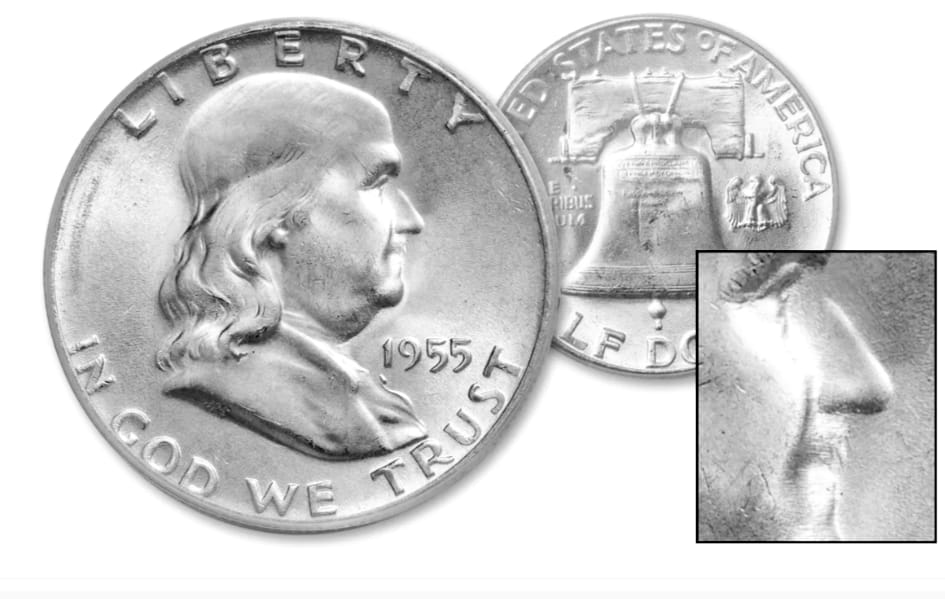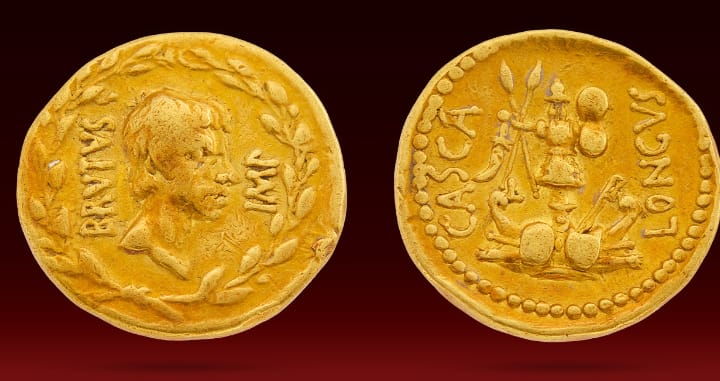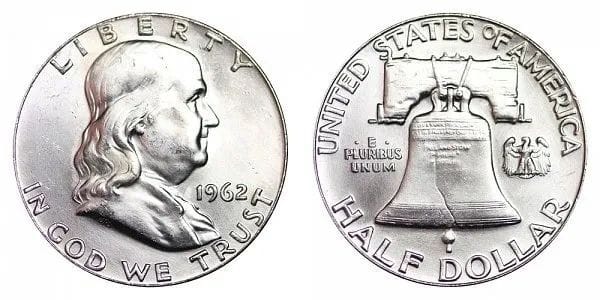- Rare Coin Weekly
- Posts
- Rare Coin Weekly
Rare Coin Weekly
Bugs Bunny Benjamin Franklin half dollar
My, What Great Big Teeth You Have!

Not only does the 1955-P Silver Franklin Half Dollar have the lowest mintage of the entire series, but it has a unique story as well – during the minting process, the dies were struck together without a blank planchet in between them. This “die clash” resulted in some of the details from the reverse ending up on the obverse, giving Benjamin Franklin a set of what many collectors describe as buck teeth – hence the coin’s nickname: The “Bugs Bunny” Franklin Half Dollar.
Because millions of Franklin Half-dollars have been melted for their 90% silver composition, many of the key dates and varieties can be difficult to find. But you can get your “Buck Tooth Ben” coin in Brilliant Uncirculated (BU) condition. A key coin for any collection, each arrives in an acrylic presentation holder with a Certificate of Authenticity
UNIQUE MINT ERROR – Thanks to a die clash between the obverse die and the reverse die, the impact pressed into the image of Benjamin Franklin near his mouth, gives Ben a set of buck teeth. Today these coins are referred to as “Bugs Bunny” Franklins.
noted, the 1955 Franklin half dollar is the lowest mintage coin of the entire series, with 48,200 coins struck. This coin is worth up to $5,000 depending on its condition, with uncirculated versions selling for up to $1,950 and Full Bell Line examples going for as much as $5,000..
Looking to purchase your own series of Benjamin Franklin uncirculated coins for your collection?
This week's top 5 Nation collector auctions / auctioneers
www.smithauctionbid.com
Hessney Auction Company LTD. https://hessney.hibid.com/auctions/
Doyle www doyle.com
Lost Dutchman rare coins. https://www.ldrcoins.com/half-cents-and-cents
Collection of Ancient Roman Coins

Consignments are currently being accepted for future auctions.
We invite you to contact us for a complimentary auction evaluation of your property.
The Carol F. Ross Collection of Ancient Roman Coins Tops $1 Million!
Highly-Anticipated Auction on June 12, 2025 Was a 'White Glove Sale' -- Every Lot Sold
A Rare and Important Aureus of Marcus Junius Brutus, 43-42 BCE, Achieved $314,600
Over 130 Ancient Coins Collected by a Noted New Haven Latin Teacher
NEW YORK, NY -- Doyle’s highly-anticipated auction on June 12, 2025 of The Carol F. Ross Collection of Ancient Roman Coins drew hundreds of numismatists and history enthusiasts from across the nation and around the globe. This remarkable collection comprised exceptionally attractive Roman Republican and Early Imperial coinage assembled by Carol F. Ross, a respected Latin teacher and former head of the Latin Department at the Foote School in New Haven, Connecticut.
Estimated to realize between $301,850 and $494,450, the sale far exceeded expectations, totaling an impressive $1,040,116—more than doubling its high estimate. A ‘White Glove Sale’—all 134 lots sold!
The centerpiece of the auction was a Rare and Important Aureus of Marcus Junius Brutus, 43-42 BCE. Estimated at $100,000-150,000, it achieved a stunning $314,600. Struck at a mobile mint of Brutus in Greece during his campaign against the Second Triumvirate, the coin is among a very limited number of aureii known to have been issued under his authority. Its portrait of Brutus offers a powerful visual connection to one of the most infamous figures in Roman history.
Another standout was an Aureus of Augustus, 27–20 BCE, which soared to $181,500—many times its $30,000-40,000 estimate. A rare type with iconography referencing Augustus’ purported return of sovereign authority to the Roman Senate, the aureus is thought to have originated from a small hoard uncovered around 1990 and believed to have been minted in Rome or possibly in Spain. Wrote Carol Ross, “Too important a symbolism to relegate this to a Spanish mint. Implication strong that it is Italian.”
Carol began collecting ancient Roman coins in the mid-1980s, at the height of her teaching career. She believed deeply in the value of learning Latin—not only for its connection to Roman history, which she loved, but for the structure and foundation it provided for understanding other languages. Her love for ancient Roman history extended beyond the classroom, drawing her to Roman coins. She was especially drawn to coins of the Republican era, captivated by the historical turmoil of the time.
Carol acquired most of her coins through trusted dealers both in New York and during her travels to Italy, organizing her finds carefully in an album. Though she never publicly displayed her collection, paging through the album in quiet contemplation brought her deep personal satisfaction. The intellectual and historical value of the coins fueled her fascination. By the late 1990s, when she stepped back from full-time teaching, new coin acquisitions had slowed. She felt satisfied that her collection was now complete.
The Collection
The Carol F. Ross Collection of Ancient Roman Coins offered a rich diversity of Roman Republican and Imperial coinage, primarily denarii and aurei, two of the most ubiquitous denominations in ancient Rome. Her eye for quality is obvious looking at the collections’ finest examples, with the term “fleur de coin” aptly used in her notes on the best-looking coins. The collection was for Ross an intensely personal pursuit; though she and her husband Stephen, a noted finance professor, collected a wide variety of things, the coin collection was assembled by her. It surely reflects her fascination with the ancient world.
Covering a period of several centuries including some of the most famous episodes of ancient Roman history, the collection is studded by popular, rare types depicting scenes, symbols, and rulers recognizable to specialists and nonspecialists alike. Many of the designs are impressively rendered (especially considering the limitations of minting technology in the period) and dynamic, depicting battle scenes, flora and fauna, historical scenes, and deities ranging from Janus to Jupiter. Emperors and familiar names—Caesar, Brutus, Augustus, Marcus Aurelius, and Nero among them—appear on coinage of the civil war and Imperial period, arguably the most profound symbol of their sovereign authority after the end of the Republic.
Carol F. Ross (1942-2025)
Born in Lexington, Massachusetts, Carol Frost Ross attended Lexington High School and continued her education at Wheaton College, majoring in Classics, a field that would become her life’s work. While at Wheaton, Carol also pursued her love of music alongside her academic pursuits. She later earned a Master’s degree in Classics from Bryn Mawr University, further deepening her expertise in the ancient world.
Carol’s teaching career began in Cambridge, Massachusetts, where she taught Latin and Greek. It was also in Cambridge where she met her future husband, Stephen A. Ross. In 1977, the couple moved to New Haven, Connecticut, where Carol joined the faculty of the Foote School. Over the years, she became head of the Latin department and was admired for her warmth, intellectual rigor, and ability to inspire students. Even after her retirement from full-time teaching in 1996, she continued sharing her passion for classical languages through tutoring and teaching at Choate Rosemary Hall and Wilbur Cross High School.
Informed by her upbringing with two sisters and a strong mother, Carol believed deeply in the importance of advancing women’s rights, especially in the realm of health. “I became a strong feminist,” she once said. “It seemed natural to me that we should be striving as a country to do more to help women, particularly concerning health.” This conviction led her to Women’s Health Research at Yale (WHRY), where she joined the Advisory Council in 2009. She became Council Chair in 2011 and held that position for a decade, helping build trust with the community and advancing the organization’s mission of equity in health research.
In parallel with her academic and
Carol found joy in nature as well, and her passion for gardening and conservation led her to the Garden Club of New Haven. As a past president and co-chair of the Club’s Centennial Committee, she worked to preserve and beautify the city’s green spaces, leaving a lasting impact on the community.
"Through My Grandfather's Eyes"
Take a tour through The Carol F. Ross Collection of Ancient Roman Coins — in Carol Ross' own words. Read More
A Selection of Auction Highlights
Lot 62 - Marcus Junius Brutus and P. Servilius Casca Longus. c. 43-42 B.C.E. AV Aureus (7.32g, 19mm).
Lot 62
Marcus Junius Brutus and P. Servilius Casca Longus. c. 43-42 B.C.E. AV Aureus (7.32g, 19mm).
Estate / Collection: The Collection of Carol F Ross
Estimate: $100,000 - $150,000
Sold for $314,600
Lot 81 - Augustus. c. 27-20 B.C.E. AV Aureus (7.84g, 20mm).
Lot 81
Augustus. c. 27-20 B.C.E. AV Aureus (7.84g, 20mm).
Estate / Collection: The Collection of Carol F Ross
Estimate: $30,000 - $40,000
Sold for $181,500
Lot 121 - Septimius Severus. c. 193-194 C.E. AV Aureus (7.34 grams, 20mm).
Lot 121
Septimius Severus. c. 193-194 C.E. AV Aureus (7.34 grams, 20mm).
Estate / Collection: The Collection of Carol F Ross
Estimate: $10,000 - $20,000
Sold for $30,250
Lot 106 - Domitian, Caesar. c. 82 C.E. AV Aureus (7.75g, 19mm).
Lot 106
Domitian, Caesar. c. 82 C.E. AV Aureus (7.75g, 19mm).
Estate / Collection: The Collection of Carol F Ross
Estimate: $8,000 - $10,000
Sold for $27,225
Very well for all their auctions.
Thank you for reading Rare Coin weekly.
Written by Andrew Cartwright
